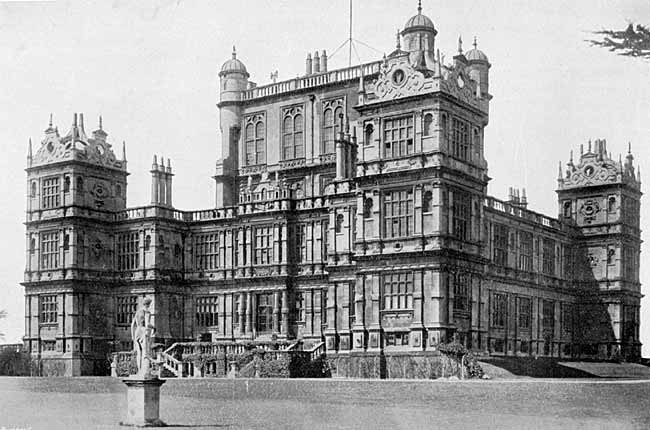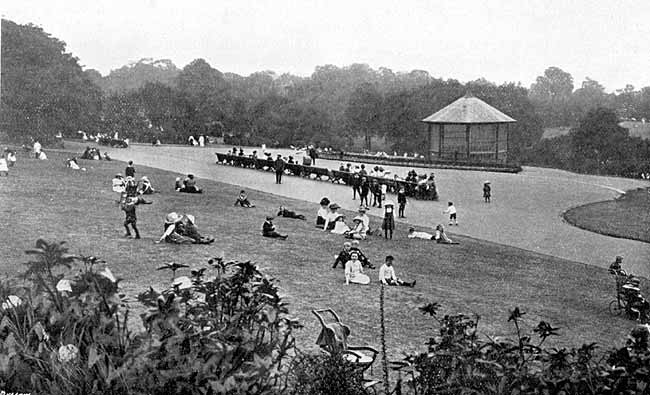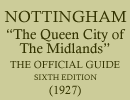WOLLATON PARK.

WOLLATON HALL Built in the year of the Spanish Armada (1588). Purchased with the Park of 744 acres, by the Nottingham Corporation in 1925.
Partly within the City and partly outside it, and enclosed by a 7ft. wall seven miles in length is Wollaton Park, with its magnificent Elizabethan Hall, its noble trees, its lovely lake, its sylvan charms, its bracken and its deer. The Park and its mansion, Wollaton Hall, covering 744 acres, were purchased by the Corporation from Lord Middleton in 1924.
The question, "Who was the designer of Wollaton Hall?" has involved no little discussion, and the honour is claimed not only for one "Mr. Robert Smythson, gent, architector and surveyor unto the most worthy house of Wollaton and diverse others of great account"—as his monument in Wollaton Church reads, but for John Thorpe and master workmen from Italy.
The conclusion reached by Mr. J. A. Gotch, the well-known authority on Renaissance architecture in England, is this: Sir Francis Willoughby, who was descended from a wealthy Nottingham wool merchant named Ralph Bugge, paid for the house which John Thorpe designed, Robert Smythson being the chief workman and clerk of the works, for in the 16th century the word "architector" meant little more than this. There is not much evidence in the design of Italian influence, except perhaps in the statuary and gondola rings, but there are traces of French design in the corner pavilions and of Dutch in the curly gables.
By building his house round a central hall, John Thorpe had to make this hall of unusual height. It is 50 feet high and the windows are 35 feet above the floor level. Thorpe's plans would appear to have been modified in the course of actual building, and these changes were probably due to Smythson.
Wollaton Hall took eight years to build, and we are told that the stone was brought from Ancaster on horseback and paid for with coal from Wollaton pits. Nevertheless the cost was £80,000. Wollaton Hall has been in constant use as a residence. Interior alterations have resulted in the disappearance of most of the Elizabethan features, including the Long Gallery, but the basement and the great hall with its roof and stone screen are as they were built.
The mansion has now been turned into a Natural History Museum, with the exception of one part reserved for such purposes as mayoral receptions, etc. The availability of this spacious house provided an admirable solution of the problem of finding more adequate accommodation for the important Natural History collection previously housed for many years at the University College. The collection as a whole is considered one of the best provincial collections of natural history objects in the country. The ground floor of the Hall is devoted to vertebrates, among which is a good series of Nottinghamshire mammals, birds and fishes. The collection of invertebrates is of great extent, importance and value, including as it does one of the finest collections of exotic butterflies in the kingdom, as well as large collections of all the other orders of insects, both British and foreign. A collection of Nottinghamshire insects is an extensive and particularly interesting feature. The collections of British fossils and of British and foreign mollusca are exceptionally comprehensive and there is a good series of minerals and rocks. A recent and highly important addition to the geological section is a collection of microscopic slides of rock slices which ranks as one of the most important in the kingdom. There is also a large herbarium of British and foreign plants. The museum is open each weekday from 11 a.m. until 7 p.m. in summer and in the winter until dusk.
THE ARBORETUM.
Beyond the School of Art are the gates which admit to that delightful spot, the Arboretum. It was opened in 1852, and its 17 acres of undulating ground include an ornamental lake with swans and other water fowl, extensive aviaries of rare and beautiful birds, and many tastefully arranged flower beds. The children amuse themselves on the grassy slopes. A striking feature of the Park is the Chinese Pagoda, in which hangs a bell captured by the Nottinghamshire Regiment during the Chinese War. Russian guns captured during the Crimean War stand at the four corners of the Pagoda, and close by is a statue of Fergus O'Connor, who represented Nottingham in Parliament for some time.

THE ARBORETUM.
As in the case of the Castle grounds, concerts by military bands are now given in the Arboretum grounds regularly throughout the summer.
